
By William Van Zyl (July 2021)
Listen to the podcast of this story and article:
https://www.podbean.com/ew/pb-spxxm-10f938c
*Additional to this article: Don’t miss the great lesson ideas at the end (for teachers, parents, and homeschoolers) – Digital Collaborative Learning.
“Rat-a-strophic,” laughed the freight plane dispatcher.
“Or, maybe Cat-o-matics,” chuckled the second dispatcher.
“They are going to get a rude awakening,” said the experienced military veteran.
The tailgate of the aeroplane was open; the officers had to hold on for dear life.
The wind violently pushed and pulled the two officers of the Royal Air Force at the gate of the freight plane – a fleet of camouflaged C130s from the UK were powering through the cold Borneo air. They resembled massive ‘iron eagles’ entering into Borneo’s airspace. The officers were attached with thin steel cables to the plane. If they fell out and their emergency parachutes took them down to the area below them, they would probably be eaten alive. A large sign covered the sides of the planes: ‘World Health Organisation (WHO) – Operations.’
The rats and mice looked up as the large eagles headed towards them. The forest held its breath.
“What on earth are they up to?” asked Ratatouille.
“I have no idea,” said Ratana.
The eyes of hundreds of predators were blinking nervously in the dim-lit belly of the plane. They were trapped. Trapped in crates. Large paper tags tied to the boxes read:
DESTINATION: Borneo – DATE: July 1956. Approved and Ratified by the WHO? ‘Operation Cat-a-strophic.’
Well, it did not read exactly like that. However, I could not resist adding some fiction to introduce this true story. Take the intro with a little bit of salt. This unique story will get very true – soon.
The crates were tied together in clumps. A giant parachute – wrapped in a camouflaged bag – sat neatly on top of every group of containers. A steel cable was attached to the bag – a static line. The function of the static line is to pull the parachute out of the bag as it exits the aeroplane. The parachute will deploy about 20 to 30 metres below the plane. It would take the predators down – slowly pendulating. It would provide them with an opportunity to see Borneo from ‘outer space.’
The rats and mice were unaware of the unique events that were about to follow.
The fleet of freight planes – engines droning and shadows fleeting – entered Borneo’s cool airspace.
When the crates bounced on the ground, they opened instantaneously. The creatures took seconds to scan the immediate environment – considering their options – then they took off to the nearest cover. They disappeared into the forest.
Soon you could hear a squeak, a tumbling sound and the rustle of leaves. The predators were at work!
Table of Contents
The why of the WHO: The true story starts here
Why did they drop 14,000 cats into Borneo? In the 1950s, the Dayak people of Borneo, an island in Southeast Asia, were suffering from an outbreak of Malaria, so they called the World Health Organization (WHO) for help. The WHO had a ready-made solution, which was to spray copious amounts of DDT around the island. With the application of DDT, the mosquitoes that carried the Malaria were knocked down, and so was the Malaria.
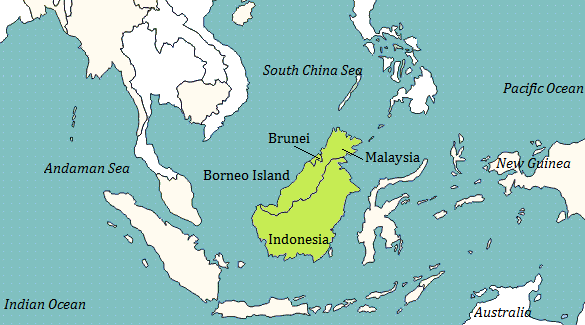
There were some interesting side effects, though. The first was that the roofs of people’s houses began to collapse on their heads. It seems the DDT not only killed off the malaria-carrying mosquitoes, but it also killed a species of parasitic wasp that, up to that point, had controlled a population of thatch-eating caterpillars. The caterpillars multiplied and flourished without the wasps and began munching their way through the villagers’ roofs.

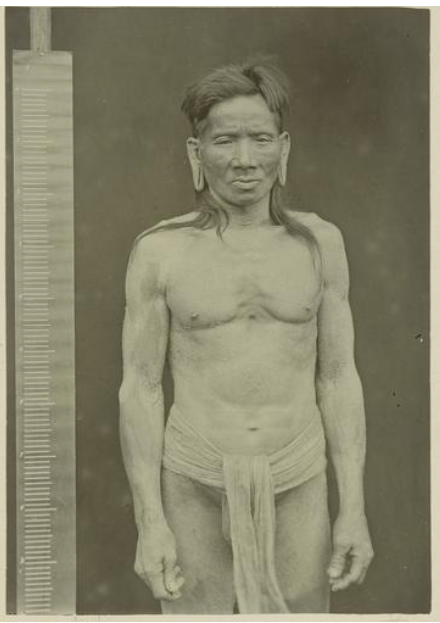
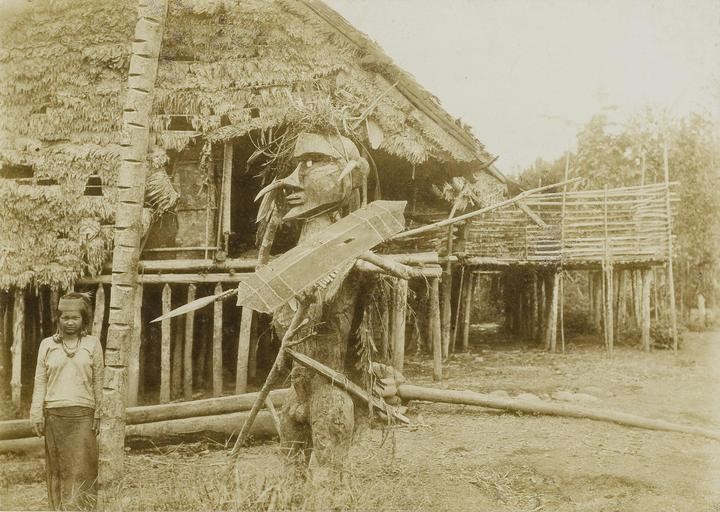
The vicious cycle begins
It was just the beginning. The DDT affected many of the island’s other insects, which were eaten by the resident population of small lizards called geckos. The biological half-life of DDT is around 8 years, so animals like geckos do not metabolize it very fast, and it stays in their system for a long time. Over time, the geckos began to accumulate pretty high loads of DDT, and while they tolerated the DDT reasonably well, the island’s resident cats, which dined on the geckos, did not. The cats ate the geckos, and the DDT contained in the geckos killed the cats. With the cats gone, the island’s population of rats came out to play, and we all know what happens when rats multiply and flourish. Pretty soon, the Dayak people were back on the phone to the World Health Organization, only this time it wasn’t Malaria they were complaining about. It was the plague and the destruction of their grain stores caused by the overpopulation of rats. This time, though, the World Health Organization didn’t have a ready-made solution and had to invent one: they decided to parachute live cats into Borneo. “Operation Cat Drop” occurred courtesy of the Royal Air Force and eventually stabilized the situation.
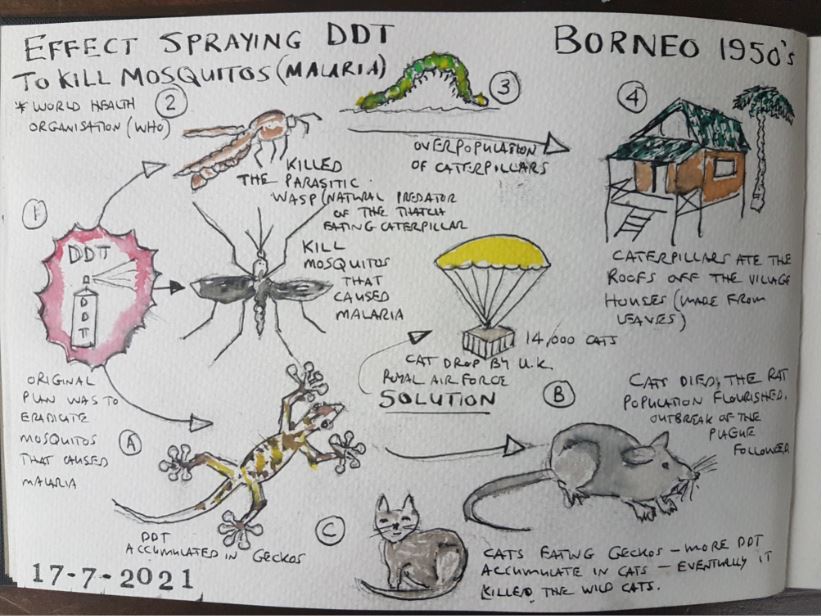
Reflection and critical thinking:
If you don’t understand the inter-relatedness of things, solutions often cause more problems.
Simple questions often require complex and reflective thinking, if reasonable solutions are to be found.
It is always better to manage by design than by default.
Source: Systems thinking: a cautionary tale (cats in Borneo)
VIDEO: Here is a brief overview of how the events unfolded.
Source: https://newomapat.wordpress.com/2015/05/13/operation-cat-drop/
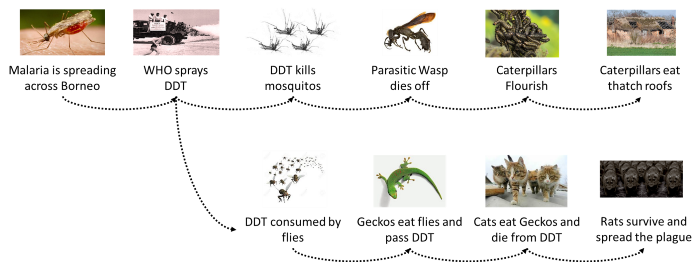
Ecosystems and Food Chains
Let’s consider eco-systems and food chains. A food chain describes how energy and nutrients move through an ecosystem. Some plants produce the energy at the primary level; then, it moves up to higher-level organisms like herbivores. After that, when carnivores eat the herbivores, energy is transferred from one to the other.
This eco-design is astonishing. The creation and regulation of these food systems are mind-blowing. How these balances and eventually the equilibrium of food chains were established are just stunning.
It is the encoded balance and control that are just so beautiful to behold. A significant intelligent design is visible behind the codes, cells, DNA, and more from a scientific perspective. It is as if a designer had been at work. We are only discovering these patterns and structures now that technology and science are advancing.
A VERSE ABOUT ENVIRONMENTAL SUSTAINABILITY: FIVE LOAVES AND TWO FISHES
“When they had all had enough to eat, he said to his disciples,
‘Gather the pieces that are left over. Let nothing be wasted.'” John 6:12
See this great example of embedded sustainability. Yeshua asked his disciples to ensure that nothing was wasted: nothing was to be thrown out! Why were 12 baskets filled with leftovers? You could also ask what does it mean? Twelve is the number of the tribes of Israel; it represents the whole people symbolically. This tells us that when food is shared fairly, with solidarity, no one was deprived of what they needed; every community could meet the needs of its poorest members. Human and environmental ecology go hand in hand. The balance – equilibrium – of all eco-systems should be protected and sustainably developed to benefit all humankind. It includes healthy ‘organic methods.’ After all, ‘food is medicine.’
SUSTAINABILITY: This story is a prompt for developing a great lesson plan for teachers: Sustainability, food chains, and eco-systems.
Learning intentions:
- Learn about food chains
- Learn about eco-systems
- Learn about biodiversity
- Learn about the equilibrium and balance in eco-systems
- Learn how to work collaboratively together (in groups). Equal collaboration and contribution
- Compare two case studies: DDT spraying in Borneo and Beaver decline in North America (preventing flooding and improving water quality). Or, choose any other cases (historical).
- Learn basic referencing when doing research. Typical APA style. Or, include a bibliography. What is the difference between the two?
- Taking action for the environment. Write a letter or make a poster (canva.com). Or, write a short article to a local newspaper. Include some photographs in your article. Consider including a diagram explaining the details (e.g. scientific)
- Develop critical thinking and reflective research skills (compare and contrast the case studies). Type up differences and things that are the same. Use a table (Google Sheets)
- Design and create digital tools to improve or solve an environmental issue or problem (e.g. programming microprocessors, design sensors, develop software and apps). For example, use the Microbit sensors and design a simple electronic mechanism. Computer programming and coding.
- Develop Global Citizenship: What is your message to the local community or the world regarding what you have discovered?
- Cultural Responsive and Relational Pedagogy: Design a diagram that portrays the food chain, eco-system or events in a case study (e.g. dwindling number of beavers in North America – or a local issue in your area). Use a different language for the headings/annotations/tags. For example: Spanish, Maori, Italian, German, Latin, and more. Can you create a simple app to translate? Explore the idea of creating an app (translate). How are apps created?
- PROJECT FOR THE ENVIRONMENT (IN GROUPS): Learn how to address a real life problem or issue, using the new knowledge. Focus on your own area/environment – for example water quality in New Zealand (Waikato)/overfishing, soil health (excess of acidification) and many more.
After analysing the DDT effect on the island of Borneo, a second case study could be “The decline of beavers in North America.” Beavers have a tremendous role to play in the quality of water. Here is a short introduction to the amazing work that beavers do for our natural habitats: ‘Beavers: Builders of Habitat and Quality Water.’ See the YouTube video below.
Copyright © 2021 by William Van Zyl
Rat-a-Strophics and Cat-o-Matics
All rights reserved. This article/eBook or any portion
thereof may not be reproduced or used in any manner
whatsoever without the express written permission of the
publisher except for the use of brief quotations in a book review.
Published by Five House Publishing (New Zealand)
First Publishing, 2021
About the Author:
The author had an exciting and unique childhood. Not as you would expect – not travelling abroad – but venturing through the fields, bushes, tools sheds, and mysterious underground tunnels around his neighbourhood. His happy place was – and still is – tinkering with ideas, science, and new possibilities. While cycling, he will often get new ideas; he brings the unexpected, the unique, and creative flurry on a page or a sketch. To this day, he dreams of vicious wars and sophisticated weaponry in an innocent child’s scout cave. He loves diagrams, timelines, cross-sections, sketches, and details of sinister and hidden concepts and ideas, always looking for a new mystery to decode and encode. He investigates and explores extravagant thoughts in children’s books and stories; he loves to portray philosophers’ perspectives, articles, intriguing stories, and poetry. Academic and research work are his forte. He always offers a practical but straightforward explanation within an engaging context. Not your ordinary thinker! A lifelong scholar and teacher.
More articles, eBooks, lessons and resources available to teachers and students at Five House Publishing.

Download PDF: https://fivehousepublishing.com/
More about the author: http://williamvanzyl.com/
Or, visit the blog: https://fivehousepublishing.com/blog-posts-grid-view/